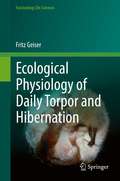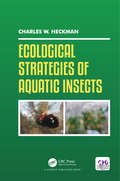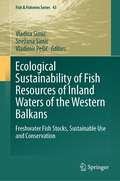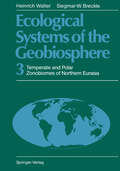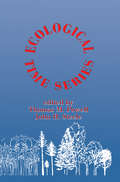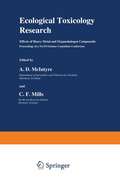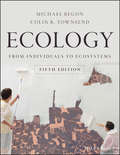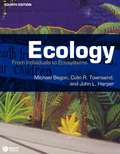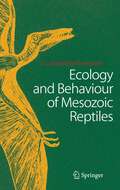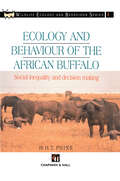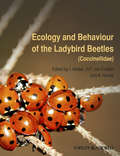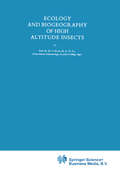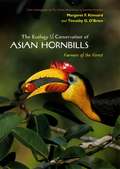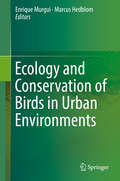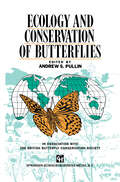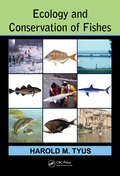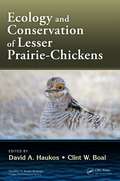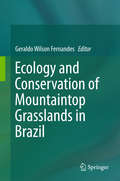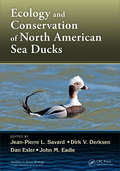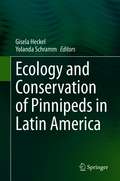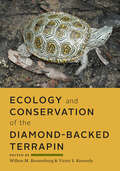- Table View
- List View
Ecological Physiology of Daily Torpor and Hibernation (Fascinating Life Sciences)
by Fritz GeiserThis book provides an in-depth overview on the functional ecology of daily torpor and hibernation in endothermic mammals and birds. The reader is well introduced to the physiology and thermal energetics of endothermy and underlying different types of torpor. Furthermore, evolution of endothermy as well as reproduction and survival strategies of heterothermic animals in a changing environment are discussed.Endothermic mammals and birds can use internal heat production fueled by ingested food to maintain a high body temperature. As food in the wild is not always available, many birds and mammals periodically abandon energetically costly homeothermic thermoregulation and enter an energy-conserving state of torpor, which is the topic of this book. Daily torpor and hibernation (multiday torpor) in these heterothermic endotherms are the most effective means for energy conservation available to endotherms and are characterized by pronounced temporal and controlled reductions in body temperature, energy expenditure, water loss, and other physiological functions. Hibernators express multiday torpor predominately throughout winter, which substantially enhances winter survival. In contrast, daily heterotherms use daily torpor lasting for several hours usually during the rest phase, some throughout the year. Although torpor is still widely considered to be a specific adaptation of a few cold-climate species, it is used by many animals from all climate zones, including the tropics, and is highly diverse with about 25-50% of all mammals, but fewer birds, estimated to use it. While energy conservation during adverse conditions is an important function of torpor, it is also employed to permit or facilitate energy-demanding processes such as reproduction and growth, especially when food supply is limited. Even migrating birds enter torpor to conserve energy for the next stage of migration, whereas bats may use it to deal with heat. Even though many heterothermic species will be challenged by anthropogenic influences such as habitat destruction, introduced species, novel pathogens and specifically global warming, not all are likely to be affected in the same way. In fact it appears that opportunistic heterotherms because of their highly flexible energy requirements, ability to limit foraging and reduce the risk of predation, and often pronounced longevity, may be better equipped to deal with anthropogenic challenges than homeotherms. In contrast strongly seasonal hibernators, especially those restricted to mountain tops, and those that have to deal with new diseases that are difficult to combat at low body temperatures, are likely to be adversely affected. This book addresses researchers and advanced students in Zoology, Ecology and Veterinary Sciences.
Ecological Strategies of Aquatic Insects
by Charles W. HeckmanThis book recounts the habits of many interesting and unusual exceptions to the rule that insects are typically terrestrial forms of life. It examines the different ways that groups of species have developed modes of existence in or on the surface of water, and gives reasons why the gross morphology of insects is not favorable for life in or near bodies of water, such as wings that fail to function after coming into contact with water, rendering them useless.
Ecological Strategies of Aquatic Insects
by Charles W. HeckmanThis book recounts the habits of many interesting and unusual exceptions to the rule that insects are typically terrestrial forms of life. It examines the different ways that groups of species have developed modes of existence in or on the surface of water, and gives reasons why the gross morphology of insects is not favorable for life in or near bodies of water, such as wings that fail to function after coming into contact with water, rendering them useless.
Ecological Sustainability of Fish Resources of Inland Waters of the Western Balkans: Freshwater Fish Stocks, Sustainable Use and Conservation (Fish & Fisheries Series #43)
by Vladica Simić Snežana Simić Vladimir PešićThis book provides a detailed evaluation of the hydro-ecological characteristics of the Western Balkans, an area characterized by still preserved inland waters and fish resources important for the European continent, as well as the biodiversity of inland waters important for the planet Earth. Freshwater ecosystems cover only 1% of the Earth's surface; however, they are a habitat for about 40% of fish species. At the same time, inland fisheries make less than 12% of the world's global fish catch, with 43% coming from low-income and food-deficient countries (Africa, South America, Southeast Asia). In Europe, the Western Balkans have significant fishing waters and fish resources, including the Middle Danube drainage (Sava, Drina, Velika Morava river systems), large ancient lakes (Skadar/Shkodra, Ohrid, Prespa, Dojran), and the Adriatic basin characterized by endemic and commercially important species. However, in contrast to the high fishing potential in a significant part of the Western Balkans, diverse and specific political, economic, and social factors largely had a negative impact on the state of fish resources. This volume is multidisciplinary and provides a sound knowledge base for scientific and practical fisheries. In addition, it may be a valuable guide for managers and conservationists worldwide to adapt methods and procedures for the ecological sustainability of fish resources under specific local, natural, and socio-economic conditions. Finally, the content is a good reference for natural sciences and agriculture students studying fish, fish resources, and fisheries sciences. It would improve their knowledge and perspectives on the challenges of sustainable use and conservation of inland water resources.
Ecological Systems of the Geobiosphere: 3 Temperate and Polar Zonobiomes of Northern Eurasia
by Heinrich Walter Siegmar-W. BreckleBy the end of the last century, the only region in all of Europe where the natural vegetation remained untouched over large expanses was Eastern Europe. Information on the vegetation of this region however, remained mostly unavailable to western scientists although the ecological approach to botanical research originated in Eastern Europe. Heinrich Walter was born in Russia, studied Natural Sciences - with emphasis on botany - in Odessa and is familiar with all relevant Russian literature on ecology. This volume thus offers scientists worldwide a unique and comprehensive survey of all relevant research, including the mostly unknown literature published in Russian.
Ecological Time Series
by Thomas M. Powell John H. SteeleThis book results from a summer school held at Cornell University in 1992. The participants were graduate students and postdoctoral researchers selected from a broad range of interests and backgrounds in ecological studies. The summer school was the second in a continuing series whose underlying aim and the aim of this volume-is to bring together the different methods and concepts underpinning terrestrial, freshwater, and marine ecology. The first volume in the series focused on patch dynamics in these three ecologi cal sectors. Here we have endeavored to complement that volume by extending its comparative approach to the consideration of ecological time series. The types of data and the methods of collection are necessarily very different in these contrasting environments, yet the underlying concept and the technical problems of analysis have much in common. It proved to be of great interest and value to the summer school participants to see the differences and then work through to an appreciation ofthe generalizable concepts. We believe that such an approach must have value as well for a much larger audience, and we have structured this volume to provide a comparable reading experience.
Ecological Toxicology Research: Effects of Heavy Metal and Organohalogen Compounds
by A. D. McIntyre C. F. MillsThe Conference on the Ecotoxicity of Heavy Metals and Organohalogen Com pounds was held under the auspices of the NATO Science Committee as part of its continuing effort to promote the useful progress of science through international cooperation. Science Committee Conferences are deliberately designed to focus atten tion on unsolved problems, with invited participants providing a variety of complementary expertise. Through intensive group discussion they seek to reach a consensus on assessments and recommendations for future research emphases, which it is hoped will be of value to the larger scientific commu nity. The subjects treated in previous Conferences have been as varied as science itself-e.g., computer software, chemical catalysis, oceanography, and materials and energy research. This volume presents an account of a meeting which evolved from studies within the Science Committee's advisory panel on Eco-Sciences. Environmental monitoring of toxic substances from industrial and agricultural sources is pro ducing a growing volume of data on the quantities of such substances in terres trial and aquatic milieus. Before this information can be used to assess biological effects, knowledge is required of the chemical form of the pollutants, the mecha nisms by which they enter and move through organisms, their concomitant transformations, the nature of the toxic reactions within tissues, and the way in which the physiology and behavior of individuals is affected.
Ecology: From Individuals to Ecosystems
by Michael Begon Colin R. TownsendA definitive guide to the depth and breadth of the ecological sciences, revised and updated The revised and updated fifth edition of Ecology: From Individuals to Ecosystems – now in full colour – offers students and practitioners a review of the ecological sciences. The previous editions of this book earned the authors the prestigious ‘Exceptional Life-time Achievement Award’ of the British Ecological Society – the aim for the fifth edition is not only to maintain standards but indeed to enhance its coverage of Ecology. In the first edition, 34 years ago, it seemed acceptable for ecologists to hold a comfortable, objective, not to say aloof position, from which the ecological communities around us were simply material for which we sought a scientific understanding. Now, we must accept the immediacy of the many environmental problems that threaten us and the responsibility of ecologists to play their full part in addressing these problems. This fifth edition addresses this challenge, with several chapters devoted entirely to applied topics, and examples of how ecological principles have been applied to problems facing us highlighted throughout the remaining nineteen chapters. Nonetheless, the authors remain wedded to the belief that environmental action can only ever be as sound as the ecological principles on which it is based. Hence, while trying harder than ever to help improve preparedness for addressing the environmental problems of the years ahead, the book remains, in its essence, an exposition of the science of ecology. This new edition incorporates the results from more than a thousand recent studies into a fully up-to-date text. Written for students of ecology, researchers and practitioners, the fifth edition of Ecology: From Individuals to Ecosystems is anessential reference to all aspects of ecology and addresses environmental problems of the future.
Ecology: From Individuals to Ecosystems (Springer-lehrbuch Ser.)
by Michael Begon Colin R. TownsendA definitive guide to the depth and breadth of the ecological sciences, revised and updated The revised and updated fifth edition of Ecology: From Individuals to Ecosystems – now in full colour – offers students and practitioners a review of the ecological sciences. The previous editions of this book earned the authors the prestigious ‘Exceptional Life-time Achievement Award’ of the British Ecological Society – the aim for the fifth edition is not only to maintain standards but indeed to enhance its coverage of Ecology. In the first edition, 34 years ago, it seemed acceptable for ecologists to hold a comfortable, objective, not to say aloof position, from which the ecological communities around us were simply material for which we sought a scientific understanding. Now, we must accept the immediacy of the many environmental problems that threaten us and the responsibility of ecologists to play their full part in addressing these problems. This fifth edition addresses this challenge, with several chapters devoted entirely to applied topics, and examples of how ecological principles have been applied to problems facing us highlighted throughout the remaining nineteen chapters. Nonetheless, the authors remain wedded to the belief that environmental action can only ever be as sound as the ecological principles on which it is based. Hence, while trying harder than ever to help improve preparedness for addressing the environmental problems of the years ahead, the book remains, in its essence, an exposition of the science of ecology. This new edition incorporates the results from more than a thousand recent studies into a fully up-to-date text. Written for students of ecology, researchers and practitioners, the fifth edition of Ecology: From Individuals to Ecosystems is anessential reference to all aspects of ecology and addresses environmental problems of the future.
Ecology: From Individuals to Ecosystems
by Michael Begon Colin R. Townsend John L. HarperBegon, Townsend, and Harper's Ecology has long been regarded as the definitive textbook on all aspects of ecology. This new edition provides a comprehensive treatment of the subject, from the first principles of ecology to the current state of the field, and aims to improve students' preparedness to address the environmental problems of the new millennium. Thoroughly revised and updated, this fourth edition includes: three new chapters on applied ecology, reflecting a rigorous, scientific approach to the ecological problems now facing mankind discussion of over 800 new studies, updating the text throughout an updated, user-friendly design with margin notes and chapter summaries that serve as study aids The resulting textbook is easy to use, lucid and up-to-date, and is the essential reference for all students whose degree program includes ecology and for practicing ecologists.
Ecology and Behaviour of Mesozoic Reptiles
by John L. Cloudsley-ThompsonThis richly illustrated book clothes the skeletons of dinosaurs and other Mesozoic reptiles with flesh, and shows how these fascinating animals evolved and probably lived. Expert author John L. Cloudsley-Thompson synthesizes current views on ecology, physiology and behaviour, and outlines the various hypotheses that have been proposed to explain their extinction. Numerous beautiful drawings of the animals and their environment illustrate this exciting monograph.
Ecology and Behaviour of the African Buffalo: Social inequality and decision making (Chapman & Hall Wildlife Ecology and Behaviour Series)
by H.H.T PrinsOver the past 30 years or so, research effort in behaviour and ecology has progressed from simple documentation of the habits or habitats of differ ent species to asking more searching questions about the adaptiveness of the patterns of behaviour observed; moved from documenting simply what occurs, to trying to understand why. Increasingly, studies of behav iour or ecology explore the function of particular responses or patterns of behaviour in individuals or populations - looking for the adaptiveness that has led to the adoption of such patterns either at a proximate level (what environmental circumstances have favoured the adoption of some particular strategy or response from within the animal's repertoire at that specific time) or at an evolutionary level (speculating upon what pres sures have led to the inclusion of a particular pattern of behaviour within the repertoire in the first place). Many common principles have been established - common to a wide diversity of animal groups, yet showing some precise relationship between a given aspect of behaviour or population dynamics and some particular ecological factor. In particular, tremendous advances have been made in understanding the foraging behaviour of animals - and the 'decision rules' by which they seek and select from the various resources on offer - and patterns of social organization and behaviour: the adap tiveness of different social structures, group sizes or reproductive tactics.
Ecology and Behaviour of the Ladybird Beetles (Coccinellidae)
by I. Hodek A. Honek H. F. van EmdenLadybirds are probably the best known predators of aphids and coccids in the world, though this greatly underestimates the diversity of their biology. Maximising their impact on their prey is an important element in modern conservation biological control of indigenous natural enemies in contrast to the classical approach of releasing alien species. Ivo Hodek is one of the most internationally respected experts on coccinellids who has researched these insects for his entire career. He has now brought together 14 scientists of international standing to author 12 chapters, making this book the definitive treatment of coccinellid biology and ecology. This volume covers the rapid scientific developments of recent years in the understanding of coccinellid phylogeny, the semiochemicals influencing their behaviour and of molecular genetics. Recent insights in relation to intraguild predation and the assessment of the predatory impact of coccinellids are also covered. Other special features of the volume are the extensive references covering the literature from both East and West and a taxonomic glossary of the up-to-date nomenclature for species of coccinellids as well as of other organisms mentioned in the text. While aimed at researchers, university teachers and agricultural entomologists, the book is readable and appropriate for others who just have a liking for these interesting and attractive insects.
Ecology and Behaviour of the Ladybird Beetles (Coccinellidae)
by Ivo Hodek A. Honek Helmut F. Van EmdenLadybirds are probably the best known predators of aphids and coccids in the world, though this greatly underestimates the diversity of their biology. Maximising their impact on their prey is an important element in modern conservation biological control of indigenous natural enemies in contrast to the classical approach of releasing alien species. Ivo Hodek is one of the most internationally respected experts on coccinellids who has researched these insects for his entire career. He has now brought together 14 scientists of international standing to author 12 chapters, making this book the definitive treatment of coccinellid biology and ecology. This volume covers the rapid scientific developments of recent years in the understanding of coccinellid phylogeny, the semiochemicals influencing their behaviour and of molecular genetics. Recent insights in relation to intraguild predation and the assessment of the predatory impact of coccinellids are also covered. Other special features of the volume are the extensive references covering the literature from both East and West and a taxonomic glossary of the up-to-date nomenclature for species of coccinellids as well as of other organisms mentioned in the text. While aimed at researchers, university teachers and agricultural entomologists, the book is readable and appropriate for others who just have a liking for these interesting and attractive insects.
Ecology and Biogeography of High Altitude Insects (Series Entomologica #4)
by M.S. ManiIn my book Introduction to High Altitude Entomology, published in 1962, I summa rized the results of eight years' studies, mainly on the Himalaya. I have since then had the opportunity of studying the collections of high altitude insects from the Alps, Carpathians, Caucasus, Urals, Alai-Pamirs, Tien Shan, Altai and other im portant mountains of the world in different museums and institutions in Europe. Through the courtesy and generosity of the Academy of Sciences of the Union of Soviet Socialist Republics, I was also able to personally collect insects and make valuable field observations on the Caucasus, the Alai-Pamirs, Ala-Tau and the Tien Shan mountains. Through comparative studies I have tried to synthesize the fundamental principles of high altitude entomology. I have described here the distinctive characters of the high altitude environment, the ecological specializations of the high altitude insects, their ecological inter relations and the outstanding peculiarities of their biogeography. I have also pre sented here an outline of the high altitude entomology of the principal mountains of the world, with brief accounts of their orogeny, geology and vegetation. This book differs from all other contributions in the field in its comparative ecological approach and in the fact that the main emphasis is throughout on the evolution of the high altitude ecosystem as an integral part of the orogeny. High mountains are, in all parts of the world, important and independent centres of origin and differ entiation of distinctive and highly specialized ecosystems and faunas.
The Ecology and Conservation of Asian Hornbills: Farmers of the Forest
by Margaret F. Kinnaird Timothy G. O'BrienHornbills are among the world’s most distinct birds. Easily recognized by their oversized beaks adorned with large casques, they range from Africa to India and throughout Asia. One of the oldest bird orders, they have been known to mankind for millennia and loom large in the mythology of indigenous cultures of tropical Asia. In the past thirty years, ecologists have uncovered many fascinating aspects of hornbill biology, from their unique nest-sealing behavior to their roles as farmers of the forest. Building on fourteen years of research, Margaret F. Kinnaird and Timothy G. O’Brien offer in Ecology and Conservation of Asian Hornbills the most up-to-date information on the evolution, reproduction, feeding ecology, and movement patterns of thirty-one species of Asian hornbills. The authors address questions of ecological functionality, ecosystem services, and keystone relationships, as well as the disturbing influence of forest loss and fragmentation on hornbills. Complemented by superb full-color images by renowned photographer Tim Laman that provide rare glimpses of hornbills in their native habitat and black-and-white illustrations by Jonathan Kingdon that highlight the intriguing aspects of hornbill behavior, Ecology and Conservation of Asian Hornbills will stand tall in the pantheon of natural history studies for years to come.
Ecology and Conservation of Birds in Urban Environments
by Enrique Murgui Marcus HedblomThis book provides syntheses of ecological theories and overarching patterns of urban bird ecology that have only recently become available. The numerous habitats represented in this book ranges from rows of trees in wooded alleys, to wastelands and remnants of natural habitats encapsulated in the urban matrix. Authored by leading scientists in this emergent field, the chapters explore how the characteristics of the habitat in urban environments influence bird communities and populations at multiple levels of ecological organization and at different spatial and temporal scales, and how this information should be incorporated in urban planning to achieve an effective conservation of bird fauna in urban environments. Birds are among the most conspicuous and fascinating residents of urban neighborhoods and provide urban citizens with everyday wildlife contact all over the world. However, present urbanization trends are rapidly depleting their habitats, and thus knowledge of urban bird ecology is urgently needed if birds are to thrive in cities. The book is unique in its inclusion of examples from all continents (except Antarctica) in an effort to arrive at a more holistic perspective. Among other issues, the individual chapters address the censusing of birds in urban green spaces; the relationship between bird communities and the structure of urban green spaces; the role of exotic plant species as food sources for urban bird fauna; the influence of artificial light and pollutants on bird fauna; trends in long-term urban bird research, and transdisciplinary studies on bird sounds and their effects on humans. Several chapters investigate how our current knowledge of the ecology of urban bird fauna should be applied in order to achieve better management of urban habitats so as to achieve conservation of species or even increase species diversity. The book also provides a forward-looking summary on potential research directions. As such, it provides a valuable resource for urban ecologists, urban ecology students, landscape architects, city planners, decision makers and anyone with an interest in urban ornithology and bird conservation. Moreover, it provides a comprehensive overview for researchers in the fields of ecology and conservation of urban bird fauna.
Ecology and Conservation of Butterflies
by Andrew S. PullinThis book was conceived to mark the Silver Jubilee of the British Butterfly Conservation Society. Interest in the conservation of butterflies has increased so rapidly that it is difficult to relate to the situation 25 years ago. Butterflies were on the decline in Britain, Europe and elsewhere but we lacked data on the extent of the decline and the underlying reasons, leaving us unable to implement effective conservation measures. An early recognition of the plight of British butterflies and moths led to the foundation of the society by a small group of conservationists in 1968. Today the society has over 10000 members, owns a number of reserves and sponsors research, conservation and monitoring activities at the local and national level. As part of the Silver Jubilee celebrations an international symposium was held at Keele University in September 1993 entitled 'Ecology and Conservation of Butterflies'. This symposium clearly showed how much important work has been done in recent years and also gave me the impression that the subject had reached a watershed. This was not because the decline of butterflies has stopped or even slowed down, far from it, the threat to our butterflies continues to increase from habitat destruction and intensification of land use. The watershed is in our understanding of the relationship between butterflies and their habitat.
Ecology and Conservation of Fishes
by Harold M. TyusWritten as a stand-alone textbook for students and a useful reference for professionals in government and private agencies, academic institutions, and consultants, Ecology and Conservation of Fishes provides broad, comprehensive, and systematic coverage of all aquatic systems from the mountains to the oceans. The book begins with overview discussio
Ecology and Conservation of Lesser Prairie-Chickens
by David A. Haukos Clint BoalShortlisted for the 2018 TWS Wildlife Publication Awards in the edited book categoryLesser Prairie-Chickens have experienced substantial declines in terms of population and the extent of area that they occupy. While they are an elusive species, making it difficult at times to monitor them, current evidence indicates that they have been persistently
Ecology and Conservation of Mountaintop grasslands in Brazil
by Geraldo Wilson FernandesThis book is a pioneer attempt to bring forward the first synthesis on the most diverse and threatened mountain top vegetation of South America, the rupestrian grasslands. It brings to light the state of the art information on this ecosystem geology, soil formation and distribution, environmental filters that lead to biodiversity, species interactions and their fine tuned adaptations to survive the harsh mountain environment. The human dimensions of the rupestrian grassland are also addressed, including the anthropogenic threats that may irreversibly impact biodiversity and ecosystem services. The book also highlights the ongoing studies on ecological restoration and first attempt to model the impacts of climate change on its speciose biota.
Ecology and Conservation of North American Sea Ducks
by Jean-Pierre L. Savard Dirk V. Derksen Dan Esler John M. EadieThe past decade has seen a huge increase in the interest and attention directed toward sea ducks, the Mergini tribe. This has been inspired, in large part, by the conservation concerns associated with numerical declines in several sea duck species and populations, as well as a growing appreciation for their interesting ecological attributes. Reflec
Ecology and Conservation of Pinnipeds in Latin America
by Gisela Heckel Yolanda SchrammPinnipeds are marine mammals that include eared seals, true seals, and walruses. This book presents detailed reviews on the ecology and conservation of 10 pinniped species along the coasts and islands in Latin America, from Mexico to Chile and Argentina. Topics covered include their population dynamics, trophic ecology, reproduction, and behavior. In addition, the book addresses major conservation issues regarding climate change, interaction with fisheries, ecotourism, and other human activities.
Ecology and Conservation of the Diamond-backed Terrapin
by Willem M. Roosenburg Victor S. KennedyThe diamond-backed terrapin is not only a uniquely evolved and beautiful turtle, it also has a long history as a vital American food source. Once so numerous that people reportedly grew tired of eating them, diamond-backed terrapins are greatly reduced in numbers today and have become an icon of salt marsh conservation. Considerably diminished in some areas and struggling to survive, this distinctive brackish water turtle is the focus of intense conservation efforts. In Ecology and Conservation of the Diamond-backed Terrapin, leading terrapin researcher Willem M. Roosenburg and experienced science editor Victor S. Kennedy have brought together a group of expert scientists to summarize our current understanding of terrapin biology, physiology, behavior, and conservation efforts. Over the course of 19 comprehensive chapters, contributors ;€¢ review the latest information on this charismatic species ;€¢ provide a detailed summary of the terrapin's natural history ;€¢ explain the threats to terrapin population stability throughout their range;€¢ examine ongoing conservation efforts to ensure the reptile's survival;€¢ present convincing arguments for the value of the diamond-backed terrapin as an estuarine indicator organism;€¢ use the terrapin as a model for studying the consequences of exploitation and environmental degradation on long-lived speciesThis exceptional book provides pivotal information for estuarine and turtle biologists, terrapin enthusiasts, natural historians, educators, conservationists, resource managers, and students. Ecology and Conservation of the Diamond-backed Terrapin is the definitive volume on this important American reptile.Contributors: Benjamin K. Atkinson, Harold W. Avery, Patrick J. Baker, Ralph E.J. Boerner, Russell L. Burke, Joseph A. Butler, Randolph M. Chambers, Paul E. Converse, Brian A. Crawford, Rusty D. Day, Dana J. Ehret, J. Whitfield Gibbons, Kathryn M. Greene, Leigh Anne Harden, Andrew S. Harrison, Kristen M. Hart, George L. Heinrich, Dawn K. Holliday, Victor S. Kennedy, Shawn R. Kuchta, Lori A. Lester, Jeffrey E. Lovich, John C. Maerz, David Owens, Allen R. Place, Taylor Roberge, Willem M. Roosenburg, Richard A. Seigel, Amanda Southwood Williard, Edward A. Standora, Anton D. Tucker, Diane C. Tulipani, Timothy J. Walsh, Thane Wibbels, Will Williams, Roger C. Wood
Ecology and Conservation of the Diamond-backed Terrapin
by Willem M. Roosenburg Victor S. KennedyThe diamond-backed terrapin is not only a uniquely evolved and beautiful turtle, it also has a long history as a vital American food source. Once so numerous that people reportedly grew tired of eating them, diamond-backed terrapins are greatly reduced in numbers today and have become an icon of salt marsh conservation. Considerably diminished in some areas and struggling to survive, this distinctive brackish water turtle is the focus of intense conservation efforts. In Ecology and Conservation of the Diamond-backed Terrapin, leading terrapin researcher Willem M. Roosenburg and experienced science editor Victor S. Kennedy have brought together a group of expert scientists to summarize our current understanding of terrapin biology, physiology, behavior, and conservation efforts. Over the course of 19 comprehensive chapters, contributors ;€¢ review the latest information on this charismatic species ;€¢ provide a detailed summary of the terrapin's natural history ;€¢ explain the threats to terrapin population stability throughout their range;€¢ examine ongoing conservation efforts to ensure the reptile's survival;€¢ present convincing arguments for the value of the diamond-backed terrapin as an estuarine indicator organism;€¢ use the terrapin as a model for studying the consequences of exploitation and environmental degradation on long-lived speciesThis exceptional book provides pivotal information for estuarine and turtle biologists, terrapin enthusiasts, natural historians, educators, conservationists, resource managers, and students. Ecology and Conservation of the Diamond-backed Terrapin is the definitive volume on this important American reptile.Contributors: Benjamin K. Atkinson, Harold W. Avery, Patrick J. Baker, Ralph E.J. Boerner, Russell L. Burke, Joseph A. Butler, Randolph M. Chambers, Paul E. Converse, Brian A. Crawford, Rusty D. Day, Dana J. Ehret, J. Whitfield Gibbons, Kathryn M. Greene, Leigh Anne Harden, Andrew S. Harrison, Kristen M. Hart, George L. Heinrich, Dawn K. Holliday, Victor S. Kennedy, Shawn R. Kuchta, Lori A. Lester, Jeffrey E. Lovich, John C. Maerz, David Owens, Allen R. Place, Taylor Roberge, Willem M. Roosenburg, Richard A. Seigel, Amanda Southwood Williard, Edward A. Standora, Anton D. Tucker, Diane C. Tulipani, Timothy J. Walsh, Thane Wibbels, Will Williams, Roger C. Wood
